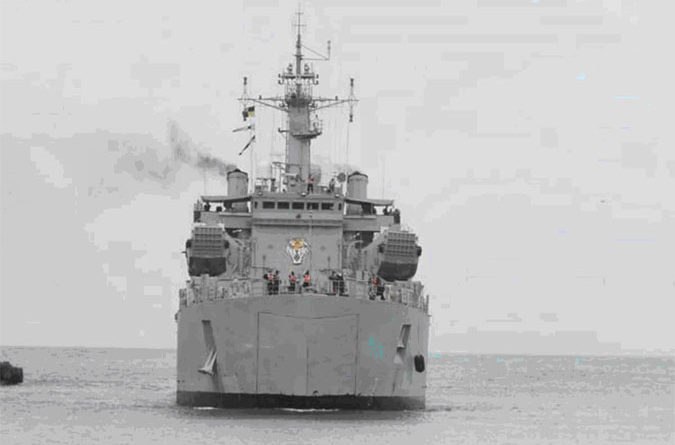Indian Navy’s IMAC To Transform Into NDMA
November 30, 2020
The International Maritime Organisation (IMO) publishes the guidelines for onboard operational use of the ship borne Automatic Identification Systems (AIS). The Indian Ocean Region (IOR) is the commercial highway for large traffic and critical for the prosperity of many nations
The Information Management and Analysis Centre (IMAC) of the Indian Navy is set to become a National Maritime Domain Awareness (NDMA) centre.
Though all including the Indian Navy and Coast Guard and related agencies are well equipped that the terror acts like 26/11 are not repeated, “The NDMA will be a multi-agency centre and will have all the stakeholders present,” according to sources.
Role of IMAC
The reason for setting this up was connecting all the operational Centres and lower rungs of the Indian Navy and the Coast Guard located along the huge coastline and the island territories.
This is the main centre of the National Command Control Communication and Intelligence System (NC3I).
And it tracks vessels on the high seas and gets data from the coastal radars.
White Shipping Agreements.
Automatic Identification Systems (AIS) transponders which are fitted on merchant ships, air and traffic management system and global shipping databases.
The approval by the DAC was given in 2012 and at the cost of around Rs 450 crore this became operational from Gurugram in 2014.
What is AIS?
Following the 26/11 terror attack, fishing vessels which are more than 20m long were directed to have AIS transponders installed. And efforts are on to include the fishing vessels which are less than 20 m to have AIS transponders. The challenge is huge in terms of tracking more than 12,000 fishing vessels present in the Indian Ocean Region (IOR).
The International Maritime Organisation (IMO) publishes the guidelines for onboard operational use of the ship borne Automatic Identification Systems (AIS).
Milind Kulshreshtha, C4I expert, explains, “AIS is mainly intended to enhance the safety of life at sea (SOLAS) through safe navigation in the marine environment. SOLAS regulations require that AIS system onboard exchange data ship-to-ship and with shore-based facilities.”
“The use of AIS is to help identify and track ships and SAR (Search and Rescue) operations and reduce the mandatory verbal information exchange. With a digital display, shipborne AIS enables the provision of automatic information by calculating Closest Point of Approach (CPA) and Time to Closest Point of Approach (TCPA) and AIS works on two dedicated VHF channels,” the C4I expert says.
How Does The AIS System Work? The Technology Behind It?
“It is an automated tracking system installed on all commercial vessels of specific tonnage. And the AIS equipment composes of a broadcast transponder system which operates in the VHF mobile maritime band” says Mr Kulshreshtha.
How Does It Work?
According to him, “It is fitted onboard individual ships for identification of ships and navigational marks closer to the vessel underway. However, it is not a Navaid against Collision avoidance procedure. Vessel Traffic Services (VTS) ashore use the AIS information to identify, locate and monitor vessel traffic. Ships fitted with AIS are required to keep the equipment operating at all times.”
What Kind Of Information Is Exchanged?
“The AIS information exchanged pertains to ship’s identity, type, position, course, speed and other safety-related information. The operating mode of AIS is continuous and autonomous on a sea-going vessel.
It is expected that Chinese ships operating in the Indo-pacific shall not either be fitted with AIS or AIS not switched on so that there is no exchange of information on ships via AIS,” Mr Kulshreshtha explains.
IFC-IOR
The Indian Ocean Region (IOR) is the commercial highway for large traffic and critical for the prosperity of many nations. Hence, threats such as maritime terrorism, piracy, trafficking, illegal fishing etc. are required to be kept subdued at all times.
A regional repository of maritime data, along with IMAC is located in Delhi NCR and the IFC-IOR is in lines with the principles listed under Security and Growth of All in the Region (SAGAR). It presently has linkages with 21 partner countries and 22 multi-national agencies across the globe.
As has been reported earlier, France became the first country to deploy a LO at the IFC-IOR and this was followed by several countries including the US, Australia, Japan and the UK who have announced their intention to post their LOs.
Maritime Domain Awareness (MDA)
During the recently concluded 2+2 Indo-US Ministerial talks in New Delhi, Indo-US agreement decided positioning a US Navy Liaison Officer (LO) at IFC-IOR and Indian LO at NAVCENT, Bahrain.
Earlier this year in March, India has joined the Indian Ocean Commission (IOC) as Observer in March along with the United Nations and Japan, and is planning to post Naval LO at the Regional Maritime Information Fusion Centre (RMIFC) in Madagascar, which functions under the aegis of the IOC.
And at the European maritime surveillance awareness in the Strait of Hormuz (EMASOH) in Abu Dhabi and has officers from Belgium, France, Netherlands and Denmark.
Why India Wants To Post-LOS?
This will help in further improving the linkages of the Navy’s IFC-IOR other IFCs. And this will then become the repository for all maritime data in the IOR. The posting of the LOs got delayed due to the global pandemic of COVID-19.
What is IOC?
Based in the southwest of the Indian Ocean, it is a five nations regional forum — Comoros, France (Reunion), Madagascar, Mauritius and Seychelles. Both the European Union (2017) and China have been observers (2016).
Courtesy: Opera News/FE Online

